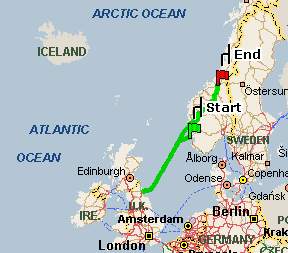It’s official: Microsoft’s flying car project is in peril, the company’s US PR agency Waggener Edstrom told us today. The mysterious vehicle that’s thrilled so many readers this week now faces the axe.
The good news is that we finally have official confirmation of these strange sightings of amphibious craft making sometimes very slow, and sometimes incredibly quick, but always unplanned detours across Europe, thanks to MapPoint or Autoroute.
But the bad news is that the fun might end soon. No longer will Norwegians, Latvians and Estonians be able to press the web equivalent of Asteroids’ “hyperspace” button and find themselves in Newcastle-upon-Tyne, England. There are no surface-effect vehicles, modeled after Alexeev’s Caspian Sea Ekranoplan, being tested in the Baltic.
Or at least, not by Microsoft. This is what we were told.
“Microsoft aggregates the most accurate and up-to-date driving directions possible for our customers using information pulled from the industry’s top data providers“, the agency tells us.
Yes, of course.
“The MapPoint team of cartographers uses the best data from each of our providers, and a complicated routing topology to calculate routes.”
A complicated routing topology? What, like this?
 Thanks to Kees Huyser
Thanks to Kees HuyserBut let’s return to the official explanation.
“We are aware that errors in the data provided to us could result in incorrect driving directions, and we work to quickly resolve any issues.”
But just in case, fit a fin and some wings.
“In this specific case one road segment was attributed incorrectly in the topology, causing the routing algorithm to ignore that road and generate the error in calculating the driving directions. We are currently working on a fix for this issue, and we expect it to be available in early February.
But we suspect that there might be more to the problem than just a solitary ignored road. Toben Mogensen from Denmark highlights this journey from Stockholm to Helsinki.

“The suggested route starts in the middle of the Baltic Sea on a ferry from Stockholm to Helsinki. Then you drive around in the Southern part of Finland before, magically, driving across the Baltic Sea on ‘local roads’ to arrive in Tallinn,” writes Toben.
“The distance is given as 68.4 miles (which sounds about right) and the estimated time for the journey is 4 hours and 36 minutes. The return journey is by the same route in reverse, only now it takes 4 hours and 53 minutes.”
So we know the flying car will do scheduled pickups – so long as you’re prepared to bob around in the North Sea.

Or wait for an Exranoplan. And not every one believes the explanation can be so simple.
“I believe this to be a decoy tactic,” writes Simon Walke. “They are involved in something far more sinister, potentially involving the relocation of thousands of Norwegian citizens.”
For proof, click for a larger version of that sinister warning from Autoroute 2003.
“The Norwegians are lovely people, but I think they might take offence at having their capital city shifted,” writes Simon.
Wormholes … for mermaids?
If it was a road missing, that would be a logical explanation. But then Christian Carey provided evidence of this fantastic voyage:
“Have a look at travelling from Sääre, Estonia (near the southern tip of the island of Saaremaa) to Ventspils, Latvia: 0.0 km net distance travelled in 3 hours, 21 minutes. Note that the starting point of the trip is about 125 km NNW of Sääre. Perhaps there are previously unpublicized wormholes throughout northern Europe? It might explain the Flying Car route optimizations…”
Or maybe the tide carries you along. Who knows? Either way, it’s a real petrol-saver.
And don’t forget the details. The last piece of advice for the Microsoft developers comes from Roy Øvrebø. He took this fantastic, high-speed boomerang journey of only 480 miles from Haugesund to Helsinki, and was advised it would take 65 hours and 58 minutes. Well of course it would. However, he noticed an error most of us who’ve used in-car GPS systems will know:
“Step 3 requires you to turn right the wrong way down a one-way street in the center of Haugesund.”
Finally, Friso Dikstelbergen claims that ten years ago he tried to trip up the DOS-based route planners for the Dutch and Belgian railways, without any success. “I couldn’t really fault them. In the end I had to resort to using the “via” box to get them to display really bad information. It just shows you how far we’ve come in ten years.”
We’ve come along way, indeed.



0 responses to “All at sea, Microsoft axes flying car project”